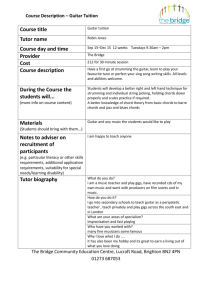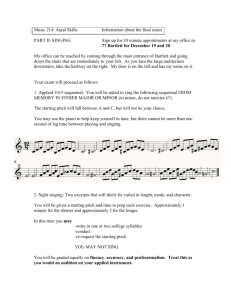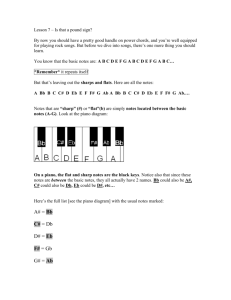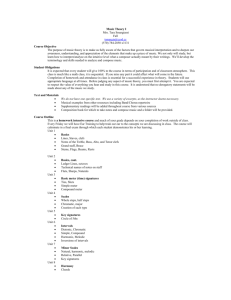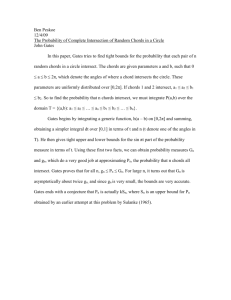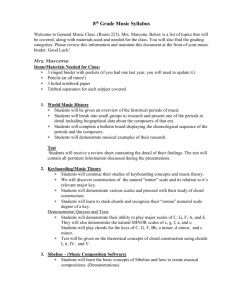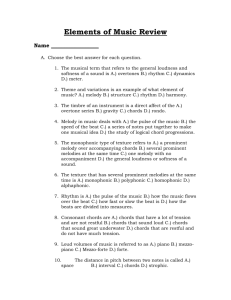G C D Em Am
advertisement
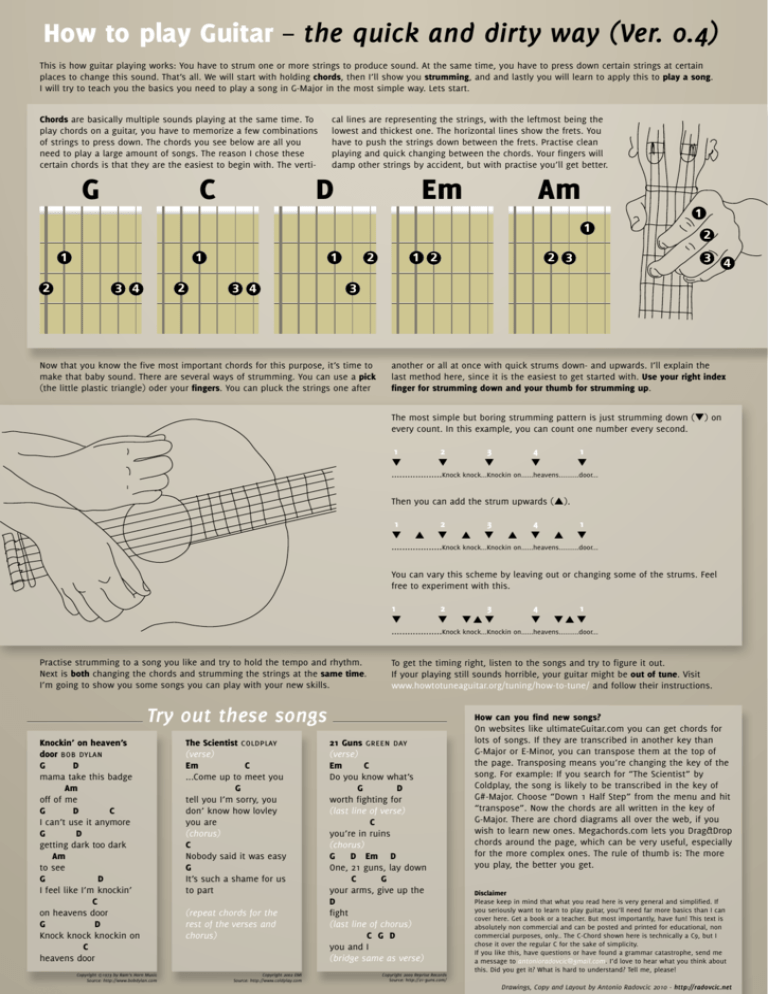
How to play Guitar – the quick and dirty way (Ver. 0.4) This is how guitar playing works: You have to strum one or more strings to produce sound. At the same time, you have to press down certain strings at certain places to change this sound. That’s all. We will start with holding chords, then I’ll show you strumming, and and lastly you will learn to apply this to play a song. I will try to teach you the basics you need to play a song in G-Major in the most simple way. Lets start. Chords are basically multiple sounds playing at the same time. To play chords on a guitar, you have to memorize a few combinations of strings to press down. The chords you see below are all you need to play a large amount of songs. The reason I chose these certain chords is that they are the easiest to begin with. The verti- G C cal lines are representing the strings, with the leftmost being the lowest and thickest one. The horizontal lines show the frets. You have to push the strings down between the frets. Practise clean playing and quick changing between the chords. Your fingers will damp other strings by accident, but with practise you’ll get better. D Em Am 1 1 1 2 1 2 3 4 2 1 3 4 1 2 2 3 2 3 4 3 Now that you know the five most important chords for this purpose, it’s time to make that baby sound. There are several ways of strumming. You can use a pick (the little plastic triangle) oder your fingers. You can pluck the strings one after another or all at once with quick strums down- and upwards. I’ll explain the last method here, since it is the easiest to get started with. Use your right index finger for strumming down and your thumb for strumming up. The most simple but boring strumming pattern is just strumming down (q) on every count. In this example, you can count one number every second. 1 2 3 4 1 q q q q q ...................Knock knock...Knockin on......heavens..........door... Then you can add the strum upwards (p). 1 2 3 4 1 q p q p q p q p q ...................Knock knock...Knockin on......heavens..........door... You can vary this scheme by leaving out or changing some of the strums. Feel free to experiment with this. 1 2 3 4 1 q q q p q q q p q ...................Knock knock...Knockin on......heavens..........door... Practise strumming to a song you like and try to hold the tempo and rhythm. Next is both changing the chords and strumming the strings at the same time. I’m going to show you some songs you can play with your new skills. To get the timing right, listen to the songs and try to figure it out. If your playing still sounds horrible, your guitar might be out of tune. Visit www.howtotuneaguitar.org/tuning/how-to-tune/ and follow their instructions. Try out these songs Kn0ckin’ 0n heaven’s d00r bob dylan G D mama take this badge Am off of me G D C I can’t use it anym0re G D getting dark t00 dark Am to see G D I feel like I’m kn0ckin’ C 0n heavens d00r G D Kn0ck knock knockin on C heavens d00r Copyright ©1973 by Ram’s Horn Music Source: http://www.bobdylan.com The Scientist coldplay (verse) Em C ...Come up to meet you G tell you I’m sorry, you don’ know how lovley you are (chorus) C Nobody said it was easy G It’s such a shame for us to part (repeat chords for the rest of the verses and chorus) Copyright 2002 EMI Source: http://www.coldplay.com 21 Guns green day (verse) Em C Do you know what’s G D worth fighting for (last line of verse) C you’re in ruins (chorus) G D Em D One, 21 guns, lay down C G your arms, give up the D fight (last line of chorus) C G D you and I (bridge same as verse) Copyright 2009 Reprise Records Source: http://21-guns.com/ How can you find new songs? On websites like ultimateGuitar.com you can get chords for lots of songs. If they are transcribed in another key than G-Major or E-Minor, you can transpose them at the top of the page. Transposing means you’re changing the key of the song. For example: If you search for “The Scientist” by Coldplay, the song is likely to be transcribed in the key of G#-Major. Choose “Down 1 Half Step” from the menu and hit “transpose”. Now the chords are all written in the key of G-Major. There are chord diagrams all over the web, if you wish to learn new ones. Megachords.com lets you Drag&Drop chords around the page, which can be very useful, especially for the more complex ones. The rule of thumb is: The more you play, the better you get. Disclaimer Please keep in mind that what you read here is very general and simplified. If you seriously want to learn to play guitar, you’ll need far more basics than I can cover here. Get a book or a teacher. But most importantly, have fun! This text is absolutely non commercial and can be posted and printed for educational, non commercial purposes, only.. The C-Chord shown here is technically a C9, but I chose it over the regular C for the sake of simplicity. If you like this, have questions or have found a grammar catastrophe, send me a message to antonioradovcic@gmail.com. I’d love to hear what you think about this. Did you get it? What is hard to understand? Tell me, please! Drawings, Copy and Layout by Antonio Radovcic 2010 - http://radovcic.net
